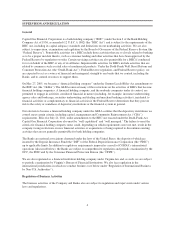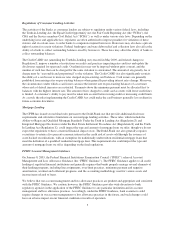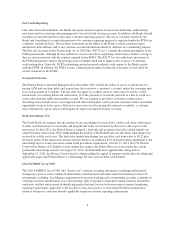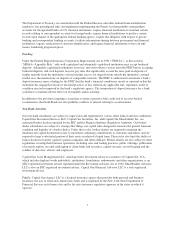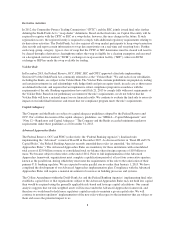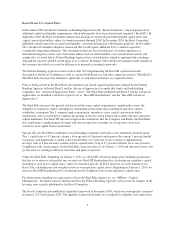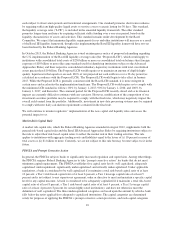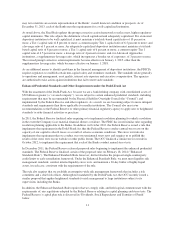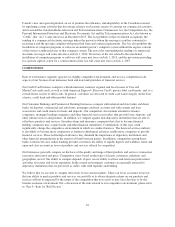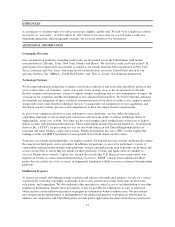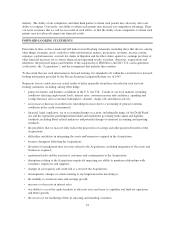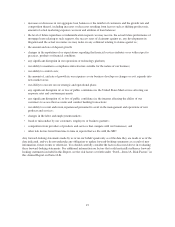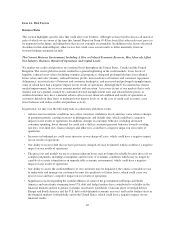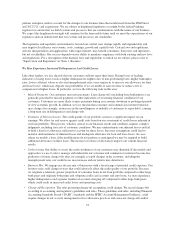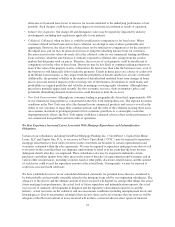Capital One 2013 Annual Report Download - page 34
Download and view the complete annual report
Please find page 34 of the 2013 Capital One annual report below. You can navigate through the pages in the report by either clicking on the pages listed below, or by using the keyword search tool below to find specific information within the annual report.Under the “cross-guarantee” provision of the Financial Institutions Reform, Recovery and Enforcement Act of 1989
(“FIRREA”), insured depository institutions such as the Banks may be liable to the FDIC with respect to any loss
incurred, or reasonably anticipated to be incurred, by the FDIC in connection with the default of, or FDIC assistance
to, any commonly controlled insured depository institution. The Banks are commonly controlled within the meaning
of the FIRREA cross-guarantee provision.
FDIC Orderly Liquidation Authority
The Dodd-Frank Act provides the FDIC with liquidation authority that may be used to liquidate non-bank
financial companies and bank holding companies if the Treasury Secretary, in consultation with the President and
based on the recommendation of the Federal Reserve and another federal agency, determines that doing so is
necessary, among other criteria, to mitigate serious adverse effects on U.S. financial stability. Upon such a
determination, the FDIC would be appointed receiver and must liquidate the company in a way that mitigates
significant risks to financial stability and minimizes moral hazard. The costs of a liquidation of a financial
company would be borne by shareholders and unsecured creditors and then, if necessary, by risk-based
assessments on large financial companies. The FDIC has issued rules implementing certain provisions of its
liquidation authority and may issue additional rules in the future.
Regulation of International Business by Non-U.S. Authorities
COBNA is subject to regulation in foreign jurisdictions where it operates, currently in the United Kingdom and
Canada.
United Kingdom
In the United Kingdom, COBNA operates through Capital One (Europe) plc, which was established in 2000 and
is an authorized payment institution regulated by the Financial Conduct Authority (the “FCA”) under the
Payment Services Regulations 2009. COEP’s indirect parent, Capital One Global Corporation, is wholly-owned
by COBNA and is subject to regulation as an “agreement corporation” under the Federal Reserve’s Regulation K.
Over the past few years, the U.K. government has made significant changes to the framework of financial
services regulation. As part of these changes, in April 2013, the Financial Services Authority (“FSA”) was split
into a new Prudential Regulatory Authority (“PRA”) and the FCA, with the FCA, rather than the PRA, regulating
COEP. In April 2014, the FCA will take over regulation of the U.K. consumer credit regime from the Office of
Fair Trading (the “OFT”). As a result of this change, the FCA will also regulate COEP’s credit card lending
activities.
During 2013, the FCA published several consultation papers setting forth its proposals to regulate consumer
credit. Although the FCA intends to replicate the existing consumer credit regime through the introduction of a
Consumer Credit Handbook, it is apparent from the draft version that some minor changes to requirements have
been made. We expect the FCA to finalize the Consumer Credit Handbook in February 2014, and for it to
become effective in April 2014.
Cross-border interchange fees continue to be under scrutiny from the European Commission (the “EC”) and the
OFT. In May 2012, the EC held that MasterCard’s “interchange” fees were anticompetitive, and the General
Court upheld this decision. The General Court held that there were no merchant or consumer benefits that could
justify the restriction on competition implied by the fee. On July 4, 2013, the European Court of Justice (“ECJ”)
heard MasterCard’s appeal of this decision. The ECJ’s judgment is expected in the first quarter of 2014. In
addition, the EC issued a statement against Visa to express its view that interchange fees are anticompetitive. The
OFT has confirmed its own investigation will remain on hold until after the outcome of MasterCard’s appeal.
Further, on July 24, 2013, the EC published the proposed new Interchange Regulations which will cap debit
interchange fees at 0.2% and credit interchange fees at 0.3%, but the cap is not expected to be effective until at
least 2015.
14


